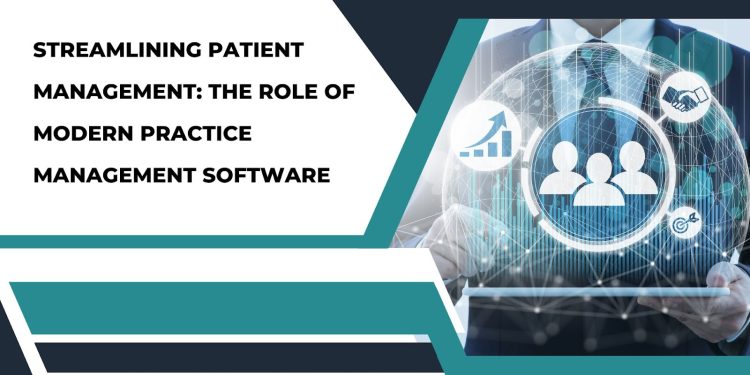The healthcare landscape is evolving rapidly. With rising costs, aging populations, and more chronic conditions, healthcare institutions face immense pressure to deliver efficient, accurate, and timely care. This urgency has led to the emergence of medical practice management software (MPMS) as a transformative tool to streamline patient management.
Table of Contents
The Need for Streamlining in Modern Healthcare
The steady rise in medical practice management software adoption reflects healthcare providers’ growing recognition of the immense value these solutions offer. The data indicates that implementation rates have risen from just over a third of providers in 2017 to over three-fourths by 2022. This rampant growth underscores the urgent need providers see for practice automation to streamline workflows and operations.
The global practice management system market is projected to reach $16.45 billion by 2028. This staggering growth underscores how MPMS has become indispensable for healthcare providers seeking to thrive in today’s landscape.
The reasons are multifold. Administrative responsibilities in healthcare have become increasingly complex. Managing scheduling, patient records, billing and insurance claims is a monumental task riddled with inefficiency when handled manually. A survey by the American Medical Association found that for every hour physicians spend with patients, nearly 2 additional hours are spent on EHR and desk work. This imbalance contributes to physician burnout.
MPMS solutions promise a revolutionary shift by automating routine administrative tasks. This streamlining reduces errors, improves turnaround time and creates bandwidth for providers to focus on delivering quality care.
Automating Administrative Tasks with MPMS
At its core, MPMS software centralizes and digitizes key administrative responsibilities.
Scheduling is optimized using automated notifications and reminders for providers and patients. Duplicate appointments and scheduling conflicts become virtually obsolete.
Patient records are integrated and accessible on a single platform rather than scattered across paper files and non-connected systems. This comprehensive view of patient history enables better care coordination, especially for facilities utilizing EHR software for behavioral health.
Billing and insurance claims processes are automated end-to-end. Claims are filed faster with fewer errors. Studies show electronic data integration in claims processing can lead to cost savings up to 70%.
Across these critical domains, MPMS solutions increase accuracy and timeliness. Administrative fatigue and burnout among providers is mitigated. And this streamlining enables staff to devote energy towards elevating patient care.
Enhancing Patient Experiences
The centralization of data under MPMS delivers another powerful advantage – the ability to connect patients to their own health information seamlessly.
Patient portals integrated with MPMS platforms provide 24/7 access to appointment scheduling, medical records, test results, billing statements and more. Patients can connect directly with care teams for questions. These portals engage patients in their own care journey like never before.
Providers also benefit from a comprehensive overview of a patient’s health history from a single dashboard. Critical information like previous diagnoses, medications, allergies and lab test results can be accessed readily. This is invaluable when caring for patients seeing multiple providers across different health systems.
Integration with Electronic Health Records
MPMS delivers immense value on its own. But tight integration with Electronic Health Records (EHRs) unlocks its full disruptive potential.
EHRs digitize patient health information within a care facility to eliminate paper records. However, EHRs have traditionally operated in silos – disconnected across locations. MPMS integrated with EHRs bridges this fragmentation.
Data flows seamlessly across connected EHR and MPMS ecosystems. The result is continuity of care and streamlined coordination. Patients can transition across various providers with minimal repetition of procedures or paperwork.
For healthcare groups with facilities across multiple locations, this integration enables centralized governance and scalability. Patient experiences and health outcomes improve dramatically.
Financial Benefits and Data Analytics
Streamlining administrative tasks produces financial advantages in addition to operational efficiency and elevated care.
Automated billing and claims management through MPMS increases revenues with accelerated payment cycles and fewer rejected claims. Studies found 20-30% revenue gains after implementing practice management solutions.
MPMS provides robust real-time analytics on financial performance. Metrics on revenue, outstanding claims, denial rates and referral patterns enable data-driven decisions. Proactive measures can be taken to prevent revenue leakage.
Challenges in Adopting MPMS
While the benefits are resounding, MPMS adoption faces real challenges.
The most substantial barrier is the upfront investment required, particularly for smaller independent practices. Uncertain returns on investment make budget approvals difficult.
Once acquired, the software implementation and workflow transition present notable complexities. Providers may struggle switching from legacy processes to digital systems. Data migration and integration with existing platforms also proves difficult.
Extensive training and change management are crucial to maximize adoption across all users. When implementation is rushed or poor, benefits will be limited.
The Future of MPMS
Despite these hurdles, MPMS adoption continues rising steadily. In fact, 77% of healthcare providers plan to invest in practice management solutions moving forward according to Definitive Healthcare, indicating that challenges are surmountable.
As MPMS platforms mature, offerings will expand from core functionality to optional value-added capabilities like telehealth, patient self-scheduling and chronic care management.
Already emerging trends like AI-enabled automation and blockchain-secured data exchange will likely accelerate. Voice technology may strengthen physician use.
Ultimately, MPMS has immense potential to transform care delivery. With sound strategies and execution, healthcare institutions can leverage these solutions to streamline patient management and thrive amid evolving healthcare landscapes.
FAQ
What are the main costs involved in implementing MPMS?
The main costs are software licensing/subscriptions, hardware, integration with existing systems, training and support. Cloud-based systems remove hardware costs. Smaller practices may qualify for subsidies. Overall costs vary based on scope and vendor.
How can MPMS data integration improve coordination for complex patients?
For patients seeing multiple providers, MPMS creates a centralized data hub that all caregivers can access with comprehensive medical history. This reduces repetition in intake questions, testing and avoids treatment conflicts. Care is streamlined.
What safeguards protect patient data privacy on MPMS platforms?
Vendors must comply with data privacy regulations like HIPAA. Encryption, access controls and patient consent help safeguard data. Cloud-based systems also have robust physical and digital security as well as backup systems.
Conclusion
The adoption of medical practice management software continues on an upward trajectory, driven by healthcare providers seeking better operational efficiency, reduced costs, and improved patient experiences. While implementing these solutions poses real financial and logistical challenges, the long-term benefits appear to outweigh the initial investments. Integrating robust MPMS with electronic health records unlocks the full potential for revolutionizing care delivery through superior data integration, care coordination, and patient engagement. As MPMS platforms grow even more sophisticated with emerging technologies like AI and blockchain, they hold the promise of transforming modern healthcare systems by streamlining administrative tasks to enable providers to focus on delivering timely, accurate, and patient-centered care. With thoughtful strategies and execution, healthcare institutions can leverage MPMS to thrive amid the complexities of 21st century healthcare.


 Home
Home










